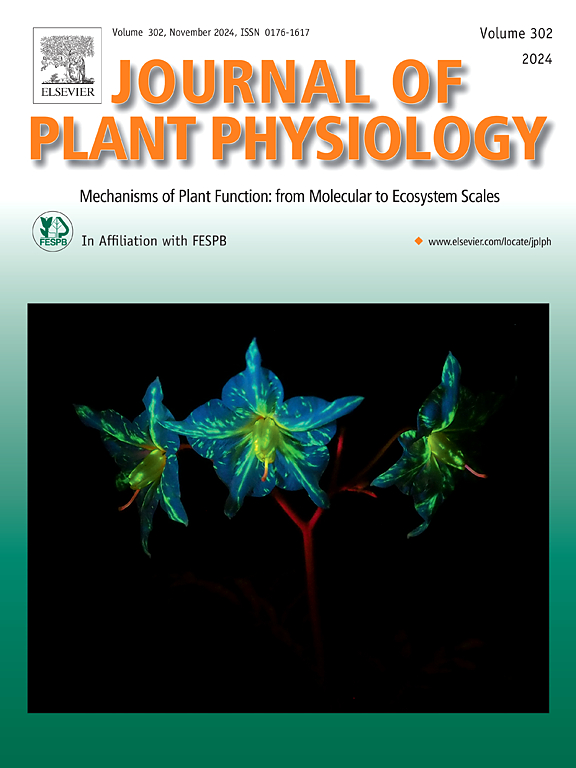花楸果实成熟过程中色素积累与花青素和叶绿素积累的代谢组学和转录组学分析
IF 4.1
3区 生物学
Q1 PLANT SCIENCES
引用次数: 0
摘要
spicata Liriope spicata广泛分布在中国,作为一种传统的中草药,通常在森林或半遮荫下种植,因其较高的观赏价值而引起了全球的广泛关注。为了更好地了解色素果实在发育和成熟过程中从浅绿色到黑色的代谢物差异,我们采用基于代谢组学和转录组学的靶向方法研究了花青素和叶绿素的生物合成机制。在5个发育阶段共鉴定出9个花青素衍生物、8个飞燕草苷衍生物、5个锦葵苷衍生物、9个天竺葵苷衍生物、6个矮牵牛花苷衍生物、4个矮牵牛花苷衍生物和8个类黄酮衍生物。转录因子MYB、bZIP和WRKY上调,激活了结构基因的表达。加权基因相关网络分析(WGCNA)的花青素、叶绿素,显示监管体系和相关基因参与亮绿色的色素黑l . spicata水果。3个苯丙氨酸脱氨酶基因(PALs)和1个保绿基因(SGR)分别参与花青素和叶绿素的生物合成。在花青素成分的相关分析中,PAL基因与不同花青素积累量密切相关,且在果实成熟的不同阶段花青素含量与PAL活性呈正相关。这些发现为进一步研究花青素和叶绿素合成的分子机制以及色素沉着变化的调控提供了新的思路。因此,这将有利于选育花青素含量高的花青素品种,提高花青素的观赏价值和研究潜在的色素和功能性原料。本文章由计算机程序翻译,如有差异,请以英文原文为准。
Anthocyanin and chlorophyll accumulation by targeted metabolomic and transcriptomic analysis involved in pigment accumulation during fruit maturation in Liriope spicata
Liriope spicata is extensively distributed in China, often cultivated under forest or in semi-shade as a traditional Chinese herbal medicine material, and has attracted widespread global interest due to its high ornamental value. To obtain a better understanding of the differential metabolites between pigmented fruit and the color change from light green to black during development and ripening, we used a targeted metabolomic- and transcriptomic-based approach to investigate the anthocyanin and chlorophyll biosynthesis mechanism. A total of 9 cyanidin derivatives, 8 delphinidin derivatives, 5 malvidin derivatives, 9 pelargonidin derivatives, 6 petunidin derivatives, 4 petunidin derivatives, and 8 flavonoid derivatives were identified in L. spicata fruit at five development stages. Transcriptional factors MYB, bZIP, and WRKY were upregulated, which activated the expression of structural genes. The weighted gene correlation network analysis (WGCNA) of anthocyanins, chlorophyll, and associated genes revealed a regulatory system involved in the pigmentation of light green to black L. spicata fruit. Three phenylalanine deaminase genes (PALs) and a stay green gene (SGR) are involved in anthocyanin and chlorophyll biosynthesis, respectively. In the correlation analysis of anthocyanin components, it was suggested that PAL genes were closely related to different anthocyanins accumulated, moreover, the anthocyanin content and PAL activity show a positive correlation at different stages of fruit maturation. These findings provide new insights into molecular mechanisms of anthocyanin and chlorophyll biosynthesis and regulation of pigmentation changes in fruit. Therefore, this will facilitate the breeding of cultivars with high levels of anthocyanin in L. spicata which enhanced ornamental value and research on potential tinctorial and functional raw material.
求助全文
通过发布文献求助,成功后即可免费获取论文全文。
去求助
来源期刊

Journal of plant physiology
生物-植物科学
CiteScore
7.20
自引率
4.70%
发文量
196
审稿时长
32 days
期刊介绍:
The Journal of Plant Physiology is a broad-spectrum journal that welcomes high-quality submissions in all major areas of plant physiology, including plant biochemistry, functional biotechnology, computational and synthetic plant biology, growth and development, photosynthesis and respiration, transport and translocation, plant-microbe interactions, biotic and abiotic stress. Studies are welcome at all levels of integration ranging from molecules and cells to organisms and their environments and are expected to use state-of-the-art methodologies. Pure gene expression studies are not within the focus of our journal. To be considered for publication, papers must significantly contribute to the mechanistic understanding of physiological processes, and not be merely descriptive, or confirmatory of previous results. We encourage the submission of papers that explore the physiology of non-model as well as accepted model species and those that bridge basic and applied research. For instance, studies on agricultural plants that show new physiological mechanisms to improve agricultural efficiency are welcome. Studies performed under uncontrolled situations (e.g. field conditions) not providing mechanistic insight will not be considered for publication.
The Journal of Plant Physiology publishes several types of articles: Original Research Articles, Reviews, Perspectives Articles, and Short Communications. Reviews and Perspectives will be solicited by the Editors; unsolicited reviews are also welcome but only from authors with a strong track record in the field of the review. Original research papers comprise the majority of published contributions.
 求助内容:
求助内容: 应助结果提醒方式:
应助结果提醒方式:


